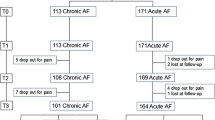Abstract
Background
Chronic anal fissures (CAFs) rarely heal with conservative management. Because they are associated with strong anal sphincter tone, most treatment aim to reduce anal pressure. Although infections can cause fissures, as can traumatic injury to the anal canal, antimicrobial treatment is not recommended. In a previous study, we reported identifying a wide spectrum of pathogenic microorganisms in the bases of CAFs, anaerobic bacteria being present in half the cases. We postulated that microbial colonization delays healing of CAF and aimed to determine whether decreasing the bacterial load with topical antibacterial treatment accelerates fissure healing.
Methods
We cultured fecal samples and swabs from the bases of CAFs in 103 patients. Patients in whose samples anaerobic bacteria were identified (47 patients) were then invited to participate in a prospective randomized clinical trial comparing topical metronidazole with conventional treatment. The primary endpoint was fissure healing confirmed on anoscopy. Secondary endpoints of maximum pain on defecation assessed by visual analog scale, maximum anal resting pressure, and rectal pH were recorded on entry and at 10, 21, and 28 days.
Results
The CAFs were colonized by mixtures of gram-positive/gram-negative anaerobic bacteria or gram-negative aerobic monocultures. Patients with anaerobic bacteria in their swabs who received topical metronidazole treatment experienced rapid relief of pain and anal sphincter spasm along with enhanced fissure healing (95.6 % healing rate compared with 70.8 % in the control group, p = 0.048).
Conclusion
Topical antimicrobial treatment can be effective in patients with CAF provided the relevant microorganisms are correctly identified.




Similar content being viewed by others
References
Lund JN, Scholefield JH. Aetiology and treatment of anal fissure. Br J Surg. 1996;83:1335–44.
Kirsch J. Anal fissure. Wien Med Wochenschr. 2004;154:69–72.
Ram E, Alper D, Stein GY, Bramnik Z, Dreznik Z. Internal anal sphincter function following lateral internal sphincterotomy for anal fissure. A long-term manometric study. Ann Surg. 2005;242:208–11.
Collins EE, Lund JN. A review of chronic anal fissure management. Tech Coloproctol. 2007;11:209–23.
Van Outryve M. Physiopathology of the anal fissure. Acta Chir Belg. 2006;106:517–8.
Lund JN. Nitric oxide deficiency in the internal anal sphincter of patients with chronic anal fissure. Int J Colorectal Dis. 2006;21:673–5.
Krylov NN. Chronic anal fissure. Vestn Khir Gastroenterol. 2008;1:5–11.
Blagodarnij LA. Treatment of chronic anal fissure. Rus Med J. 2002;10:1327–30.
Lund JN, Nyström PO, Coremanset G, et al. An evidence-based treatment algorithm for anal fissure. Tech Coloproctol. 2006;10:177–80.
Zbar AP, Aslam M, Allgar V. Faecal incontinence after internal sphincterotomy for anal fissure. Tech Coloproctol. 2000;4:25–8.
Utzig MJ, Kroesen AJ, Buhr HJ. Concepts in pathogenesis and treatment of chronic anal fissure—a review of the literature. Am J Gastroenterol. 2003;98:968–74.
Sileri P, Stolfi VM, Franceschilliet L, et al. Conservative and surgical treatment of chronic anal fissure: prospective longer term results. J Gastrointest Surg. 2010;14:773–80.
Carapeti EA, Kamm MA, McDonald PJ, Phillips RK. Double-blind randomised controlled trial of effect of metronidazole on pain after day-case haemorrhoidectomy. Lancet. 1998;351:169–72.
Nicholson TJ, Armstrong D. Topical metronidazole (10%) decreases posthemorrhoidectomy pain and improves healing. Dis Colon Rectum. 2004;47:711–6.
Pelta AE, Davis KG, Armstrong DN. Subcutaneous fissurotomy: a novel procedure for chronic fissure-in-ano. a review of 109 cases. Dis Colon Rectum. 2007;50:1662–7.
Hosseini SV, Sabet B, Nouri Amirkolaee M, Bolandparvaz S. A randomized clinical trial on the effect of oral metronidazole on wound healing and pain after analsphincterotomy and fissurectomy. Arch Iran Med. 2008;11:550–2.
Holt JG, Krieg NR, Sneath PNA, et al. Bergey's Manual of Systematic Bacteriology. Mir, Moscow. 1997. (In Russian)
Abcarian H, Lakshmahan S, Read DR, Roccaforte P. The role of internal sphincter in chronic anal fissures. Dis Colon Rectum. 1982;25:525–8.
Janicke DM, Pundt MR. Anorectal disorders. Emerg Med Clin North Am. 1996;14:757–88.
Grekova NM, Telesheva LF, Maleva ЕА, Gritzenko VA, Bahareva LI, Kandalova EN. Analysis of antibiotic sensitivity of microflora of chronic anal fissure in the therapy optimization. Kurskiy Nauch-Pract Vestn. 2012;1:76–81.
Grekova NM, Lebedeva YV, Maleva ЕА. Clinical, endoscopic and microbiological features of chronic anal fissure without spasm of anal sphincter. Sovr Probl Nauk Obraz. 2013;1:83–91.
Maleva ЕА, Grekova NM, Telesheva LF, Kandalova EN. Outpatient treatment of patients with chronic anal fissure on the background of proctitis and colon dysbiosis. Izv Visch Uch Zaved Ural Reg. 2012;1:154–61.
Grekova NM, Maleva ЕА, Bordunovskij VN, Lebedeva YV. Role of selective decontamination in combined treatment of chronic anal fissure. Vestn Khir Im I I Grek. 2011;170:67–71.
Conflict of interest
NMG, EAM, YL, VNB, LFT, and VAB declare that they have no conflict of interest.
Ethics statement
The authors declare that the study was performed in a manner to conform with the Helsinki declaration of 1975, as revised in 2000 and 2008 concerning human and animal rights, and the authors followed the policy concerning informed consent as shown on Springer.com. All patients gave written informed consent for participation in the study.
Author information
Authors and Affiliations
Corresponding author
Rights and permissions
About this article
Cite this article
Grekova, N.M., Maleva, E.A., Lebedeva, Y. et al. The effects of topical application of metronidazole for treatment of chronic anal fissure: A randomized, controlled pilot study. Indian J Gastroenterol 34, 152–157 (2015). https://doi.org/10.1007/s12664-015-0559-2
Received:
Accepted:
Published:
Issue Date:
DOI: https://doi.org/10.1007/s12664-015-0559-2




